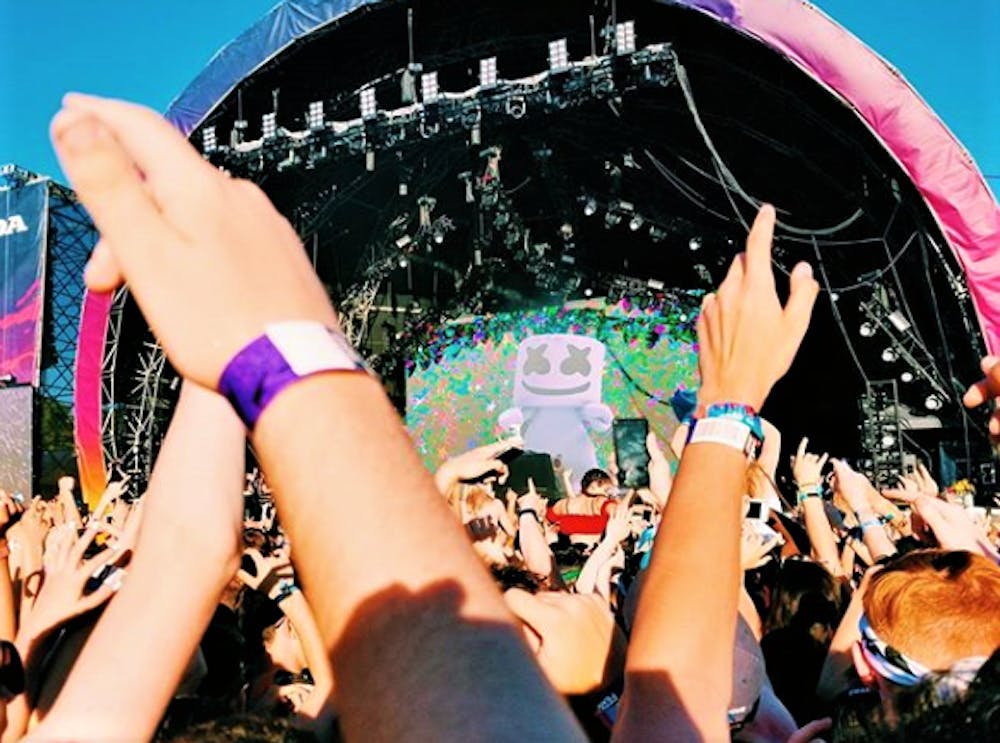In May 2017, a new–aged Lord of the Flies took place with Instagram influencers and the millennial elite ransacking an island for shelter, subsistence, and WiFi connection. The infamous Fyre Festival, a joint venture between hip–hop heavyweight Ja Rule and Bucknell University dropout Billy McFarland, recently became the topic of scathing Netflix and Hulu documentaries. These documentaries aim to answer two questions almost as large as the music festival McFarland aimed to throw: why did Fyre Festival fail so spectacularly and who’s to blame? The answer, shockingly, starts with ourselves.
Fyre Festival symbolizes the new era of the music festival, where music takes a backseat to the spectacle. This very notion would make the creators of Woodstock–a festival short on merch yet full of music–shudder. After all, these multi–day festivals are supposed to be accessible. Music festivals provide access to dozens of artists in stripped–down performances all for the price of a couple of textbooks. At the 2017 iteration of the Governors Ball Music Festival, which is New York City’s answer to Coachella and Lollapalooza, fans paid $305 for a regular three–day pass granting access to 67 artists. In case math isn’t your thing, that’s approximately $4.50 per act–or about the price of a fancy Starbucks latte.
Moreover, festival performances should maintain a grassroots aura. Despite taking place in the great open expanse, a good 40–minute festival set should feel intimate, as though you’re seeing the human side of the performer–who they are when they sing in the car, stripped of stadium level production and studio quality mixing. They’re Jimi Hendrix playing a 9 a.m. set that extended well past two hours at Woodstock and Prince covering Radiohead’s loner anthem “Creep” at 2008 Coachella. They’re you, in the audience on your best friend’s shoulders, screaming lyrics with thousands of others who also think this moment belongs only to them.

Music festivals are not, however, incubators of Instagram clout. Their purpose isn’t to provide “flex only” spaces for attendants to remove themselves from the heart of music festivals: the general admission pit. And yet, if you were to study the VIP packages of the most prominent music festivals in America, you’d think the exact point of music festivals was exclusion. Currently, Coachella’s most expensive ticket package is a $9500 "glamping" experience that includes a golf cart chauffeur and catered brunches, which would admittedly make for some pretty sick Instagram story content. That being said, it removes you from the energy of the festival. You’re not scrambling from act to act, wading through the crowd to earn your coveted front row spot. You’re not foraging for reasonably–priced food. You’re not hungry, you’re not tired, you’re not sweaty. You’re simply floating above the experience–there but not present.
This detachment permeates nearly all modern music festivals. Even without buying VIP tickets, it almost feels as though my generation, Gen–Z, enjoys experiencing their own memories vicariously and lives through their own Instagram and Snapchat posts. Fyre Festival’s entire structure demonstrates that. The point of the festival wasn’t to sell a concert or to bring people together. It was to sell “a dream, a vacation, a concept,” said Grant Margolin, the festival’s marketing director in the Netflix documentary. “Who was playing, what the food was going to be, all the things that typically sold a music festival weren’t the sales point.”
And yet, the festival outsold its expectations. The festival sold out the site’s capacity in approximately two days, prompting McFarland to begin overselling and creating grander, pricier, and more exclusive ticket packages and add–ons that would further insulate the attendants from an authentic experience. They advertised yacht parties, secluded beachside residences, and private planes as essential to a worthwhile music festival experience. In reality, all that’s essential to a good music festival is good music and good company.

Still, despite Fyre Festival’s epic failure, music festivals are copying its central ethos. They aren't prioritizing the music first, or second, or even tenth. They are slotting it at the bottom of a mile long laundry list. At the 2018 iteration of Panorama, the company behind Coachella’s east coast venture, music felt like an accessory. The festival boasted an interactive HP art experience entitled The Lab, where festival attendees could insert themselves in 360–degree virtual reality theater, dance with balloons, and get their auras read. This same festival failed to deliver on nearly all of its opening day headliners due to a faulty weather prediction and canceled Lil Wayne’s performance 25 minutes into his set because he still hadn’t arrived on festival grounds. Predictably, the festival is on hiatus for 2019.
Overall, the future of the music festival is grim. Gen–Z is killing them, just not in the way we think. By appealing to the 21st century need for status, for followers, for experience projected but not lived, the head honchos in board rooms are draining the soul from festivals. They’re commodifying what Woodstock intended to be–anti–establishment. In 2014, the five biggest North American music festivals earned $183 million in combined ticket sales. With profits like those, music festivals could exist indefinitely. They just won’t be about the music.







